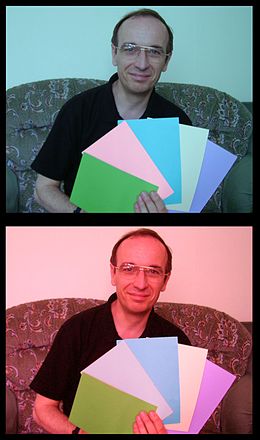- Color constancy
-
 Color constancy: The colors of a hot air balloon are recognized as being the same in sun and shade
Color constancy: The colors of a hot air balloon are recognized as being the same in sun and shade Constancy makes square A appear darker than square B, when in fact they are both exactly the same shade of grey. See Same color illusion
Constancy makes square A appear darker than square B, when in fact they are both exactly the same shade of grey. See Same color illusion
Color constancy is an example of subjective constancy and a feature of the human color perception system which ensures that the perceived color of objects remains relatively constant under varying illumination conditions. A green apple for instance looks green to us at midday, when the main illumination is white sunlight, and also at sunset, when the main illumination is red. This helps us identify objects.
Contents
Physiological basis
The physiological basis for color constancy is thought to involve specialized neurons in the primary visual cortex that compute local ratios of cone activity, which is the same calculation that Land's retinex algorithm uses to achieve color constancy. These specialized cells are called double-opponent cells because they compute both color opponency and spatial opponency. Double-opponent cells were first described by Nigel Daw in the goldfish retina[citation needed]. There was considerable debate about the existence of these cells in the primate visual system; their existence was eventually proven using reverse-correlation receptive field mapping and special stimuli that selectively activate single cone classes at a time, so-called "cone-isolating" stimuli.[1][2]
Color constancy works only if the incident illumination contains a range of wavelengths. The different cone cells of the eye register different ranges of wavelengths of the light reflected by every object in the scene. From this information, the visual system attempts to determine the approximate composition of the illuminating light. This illumination is then discounted[3] in order to obtain the object's "true color" or reflectance: the wavelengths of light the object reflects. This reflectance then largely determines the perceived color.
Retinex Theory
The effect was described in 1971 by Edwin H. Land, who formulated "retinex theory" to explain it. The word "retinex" is a portmanteau formed from "retina" and "cortex", suggesting that both the eye and the brain are involved in the processing.
The effect can be experimentally demonstrated as follows. A display called a "Mondrian" (after Piet Mondrian whose paintings are similar) consisting of numerous colored patches is shown to a person. The display is illuminated by three white lights, one projected through a red filter, one projected through a green filter, and one projected through a blue filter. The person is asked to adjust the intensity of the lights so that a particular patch in the display appears white. The experimenter then measures the intensities of red, green, and blue light reflected from this white-appearing patch. Then the experimenter asks the person to identify the color of a neighboring patch, which, for example, appears green. Then the experimenter adjusts the lights so that the intensities of red, blue, and green light reflected from the green patch are the same as were originally measured from the white patch. The person shows color constancy in that the green patch continues to appear green, the white patch continues to appear white, and all the remaining patches continue to have their original colors.
Color constancy is a desirable feature of computer vision, and many algorithms have been developed for this purpose. These include several retinex algorithms.[4] These algorithms receive as input the red/green/blue values of each pixel of the image and attempt to estimate the reflectances of each point. One such algorithm operates as follows: the maximal red value rmax of all pixels is determined, and also the maximal green value gmax and the maximal blue value bmax. Assuming that the scene contains objects which reflect all red light, and (other) objects which reflect all green light and still others which reflect all blue light, one can then deduce that the illuminating light source is described by (rmax, gmax, bmax). For each pixel with values (r, g, b) its reflectance is estimated as (r/rmax, g/gmax, b/bmax). The original retinex algorithm proposed by Land and McCann uses a localized version of this principle[5][6].
Although retinex models are still widely used in computer vision, they have been shown not to accurately model human color perception.[7]
See also
References
- ^ Conway BR and Livingstone MS (2006) Spatial and Temporal Properties of Cone Signals in Alert Macaque Primary Visual Cortex (V1). Journal of Neuroscience 26(42):10826-46 [cover illustration].
- ^ Conway BR (2001) Spatial structure of cone inputs to color cells in alert macaque primary visual cortex (V-1). Journal of Neuroscience 21(8):2768-2783. [cover illustration]
- ^ "Discounting the illuminant" is a term introduced by Helmholtz: McCann, John J. (March 2005). "Do humans discount the illuminant?". In Bernice E. Rogowitz, Thrasyvoulos N. Pappas, Scott J. Daly,. Proceedings of SPIE. 5666. Human Vision and Electronic Imaging X. pp. 9–16. doi:10.1117/12.594383.
- ^ Jean-Michel Morel, Ana B. Petro and Catalina Sbert (2009) Fast implementation of color constancy algorithms. Proc. SPIE, Vol. 7241, 724106
- ^ Edoardo Provenzi, Luca De Carli, Alessandro Rizzi, Daniele Marini (2005) Mathematical definition and analysis of the Retinex algorithm. JOSA A, Vol. 22, Issue 12, pages 2613-2621.
- ^ Marcelo Bertalmío, Vicent Caselles, Edoardo Provenzi (2009) Issues About Retinex Theory and Contrast Enhancement. IJCV, Vol. 83, pages 101–119.
- ^ Hurlbert, A.C.; Wolf, K. The contribution of local and global cone-contrasts to colour appearance: a Retinex-like model. In: Proceedings of the SPIE 2002, San Jose, CA
Retinex
Here "Reprinted in McCann" refers to McCann, M., ed. 1993. Edwin H. Land's Essays. Springfield, Va.: Society for Imaging Science and Technology.
- (1964) "The retinex" Am. Sci. 52(2): 247-64. Reprinted in McCann, vol. III, pp. 53–60. Based on acceptance address for William Procter Prize for Scientific Achievement, Cleveland, Ohio, December 30, 1963.
- with L. C. Farney and M. M. Morse. (1971) "Solubilization by incipient development" Photogr. Sci. Eng. 15(1):4-20. Reprinted in McCann, vol. I, pp. 157–73. Based on lecture in Boston, June 13, 1968.
- with J. J. McCann. (1971) "Lightness and retinex theory" J. Opt. Soc. Am. 61(1):1-11. Reprinted in McCann, vol. III, pp. 73–84. Based on the Ives Medal lecture, October 13, 1967.
- (1974) "The retinex theory of colour vision" Proc. R. Inst. Gt. Brit. 47:23-58. Reprinted in McCann, vol. III, pp. 95–112. Based on Friday evening discourse, November 2, 1973.
- (1977) "The retinex theory of color vision" Sci. Am. 237:108-28. Reprinted in McCann, vol. III, pp. 125–42.
- with H. G. Rogers and V. K. Walworth. (1977) "One-step photography" In Neblette's Handbook of Photography and Reprography, Materials, Processes and Systems, 7th ed., J. M. Sturge, ed., pp. 259–330. New York: Reinhold. Reprinted in McCann, vol. I, pp. 205–63.
- (1978) "Our 'polar partnership' with the world around us: Discoveries about our mechanisms of perception are dissolving the imagined partition between mind and matter" Harv. Mag. 80:23-25. Reprinted in McCann, vol. III, pp. 151–54.
- with D. H. Hubel, M. S. Livingstone, S. H. Perry, and M. M. Burns. (1983) "Colour-generating interactions across the corpus callosum" Nature 303(5918):616-18. Reprinted in McCann, vol. III, pp. 155–58.
- (1983) "Recent advances in retinex theory and some implications for cortical computations: Color vision and the natural images" Proc. Natl. Acad. Sci. U. S. A. 80:5136-69. Reprinted in McCann, vol. III, pp. 159–66.
- (1986) "An alternative technique for the computation of the designator in the retinex theory of color vision" Proc. Natl. Acad. Sci. U. S. A. 83:3078-80.
External links
- Color constancy - McCann
- Color constancy - Illuminant Estimation
- Retinex Image Processing
- Retinex implemented via a partial differential equation and Fourier transform, with code and on-line demonstration
Color topics Color perception Color vision · Color blindness · Visible spectrum · Color constancy · Color term · Color theory · Complementary color
Color space Basic colors Related
Wikimedia Foundation. 2010.



